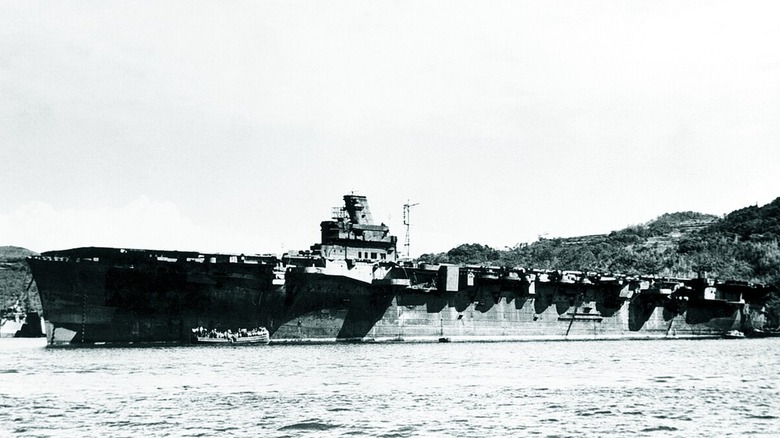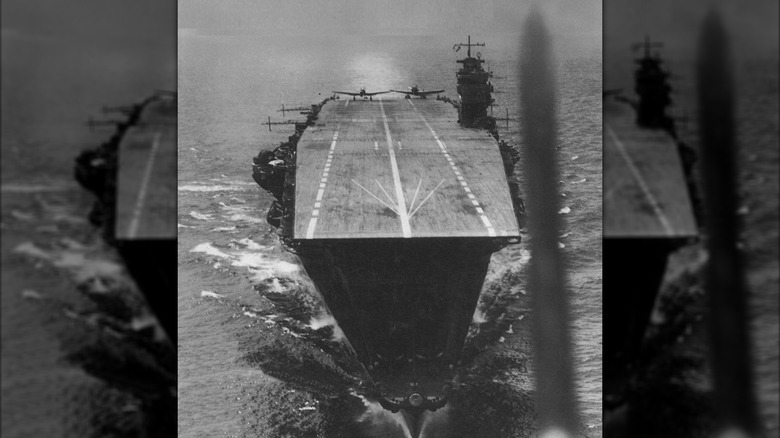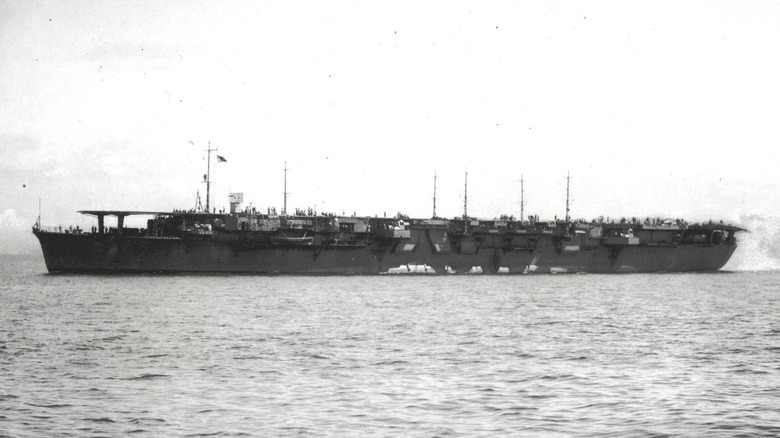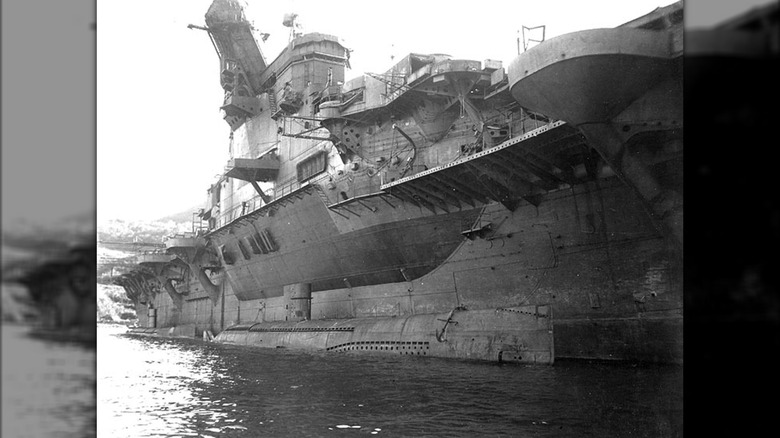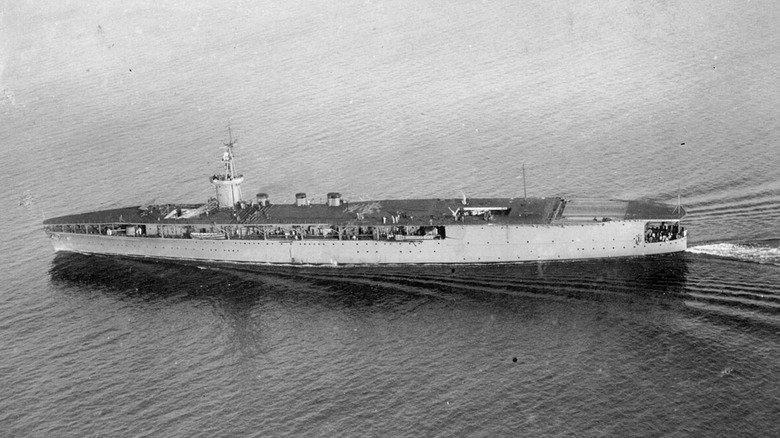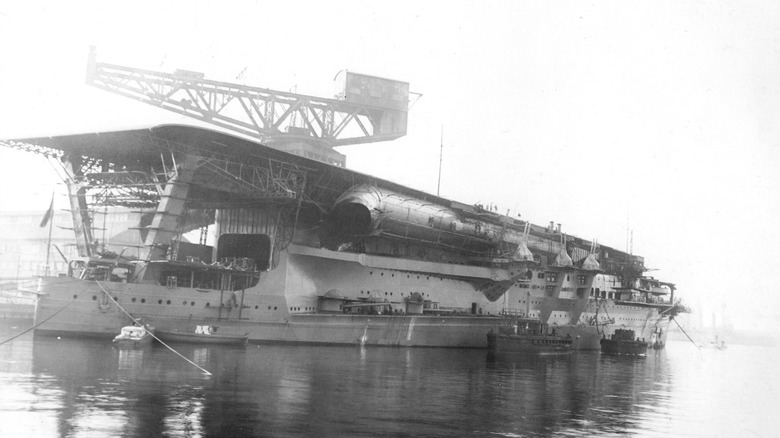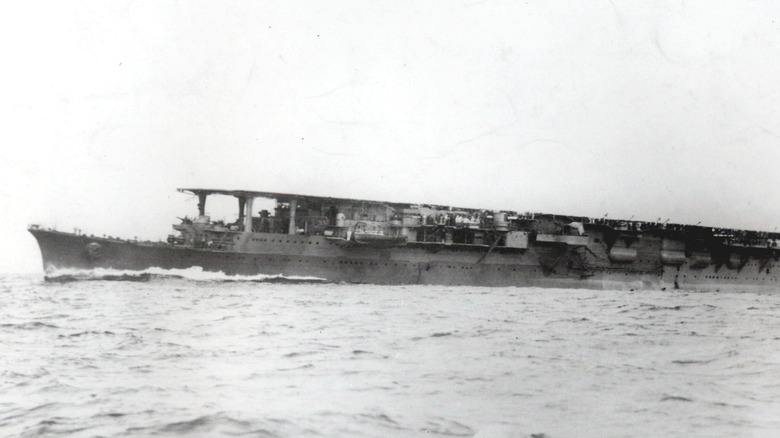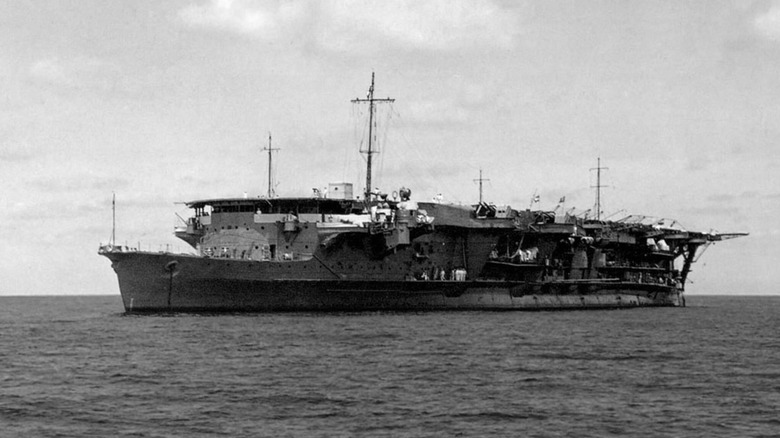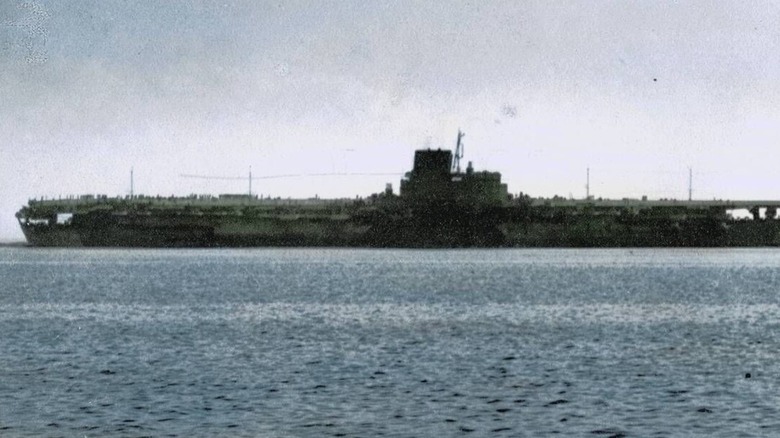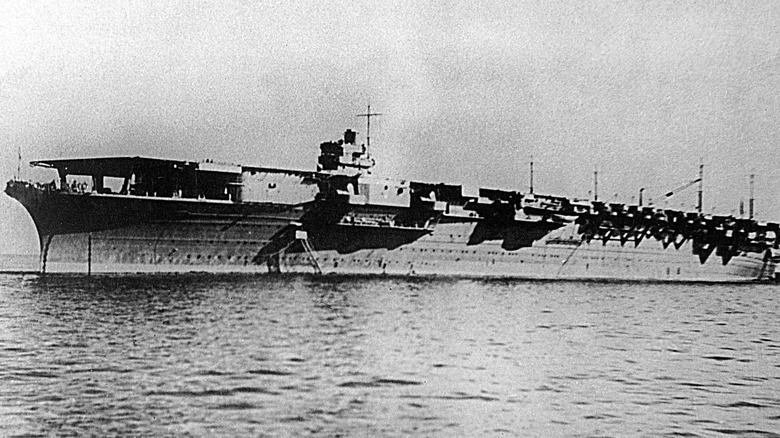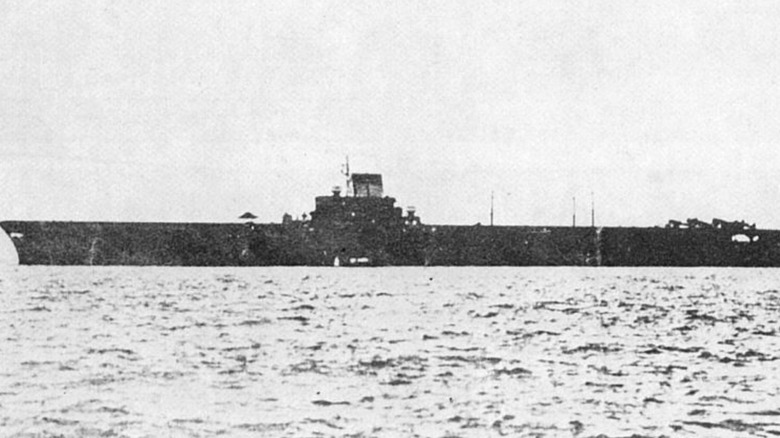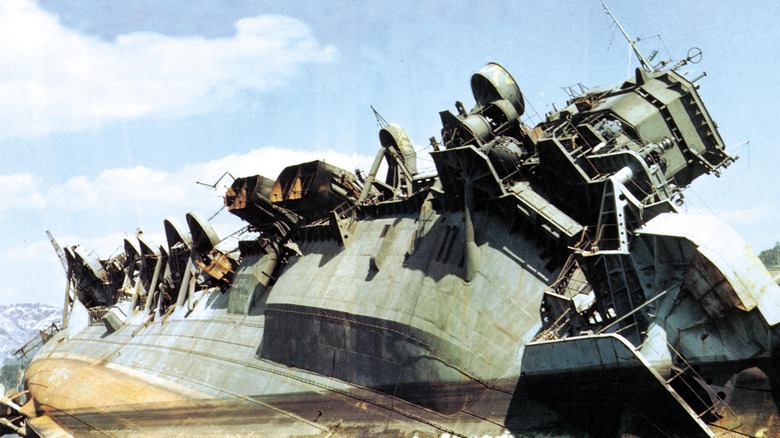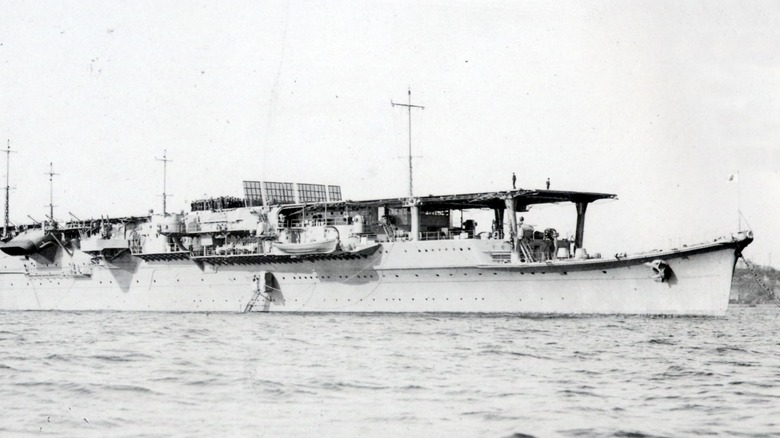Every Aircraft Carrier Japan Had Active During World War 2
Soon after the invention and mass adoption of airplanes, governments started used them for war. Suddenly, soldiers had to watch out for flying machines spraying hot lead and dropping bombs. However, while most combat-oriented planes excel in mobility and destructive capabilities, they are sorely lacking in travel distance. Even modern fighters like the F-35 can only fly for about an hour — half that during combat. So how do you deploy military planes in locations far away from established runways and hangars? Take the runways and hangars with you.
If airplanes changed the face of warfare, aircraft carriers were the body that followed. Not only could airplanes launch from seafaring platforms, they also added another element to naval warfare. While the first aircraft carriers can be traced back to World War I, they didn't truly impact international conflicts until World War II. The United States had more aircraft carriers than any other country during that period, with Japan sitting at a distant second. However, the Empire of Japan's armada was still impressive.
IJN Akagi
The IJN Akagi was one of Japan's earlier aircraft carriers, but it didn't start out that way. The ship was initially laid down as an Amagi-class battlecruiser, and building teams shifted gears during development and used the framework to create an aircraft carrier. When the ship was complete, it was 261 meters (856.3 feet) long and housed a total of 1,630 personnel and 88 planes. In a stroke of cosmic irony, the Akagi was the only Amagi-class "battlecruiser" ever completed; the rest were scrapped.
The Akagi officially entered service in 1927 and had a fairly successful career until 1942. The ship participated in numerous operations before and during World War 2, including the Pearl Harbor attack, the Battle of Rabaul (New Guinea), and the Battle of Midway. While the Akagi technically survived the Battle of Midway, a 1,000-pound bomb struck the ship's middle elevator, which caused a chain reaction of explosions to rip through the vessel, rendering it virtually inoperable. Left with no other choice, the Akagi was scuttled (intentionally and deliberately sunk).
Chitose-class Carrier
To prevent an arms race after World War 1, several governments signed the Washington Naval Treaty of 1922 to limit the construction of wartime naval vessels. However, many signers only followed the letter of the treaty, not the spirit.
While Japanese engineers altered the Akagi to comply with the Washington Naval Treaty, the Chitose-class carriers were intended to "cheat" the treaty. These ships, which consisted of the IJN Chitose and IJN Chiyoda, were designed as seaplane tenders (ships that supported the operation of seaplanes) that could quickly convert into aircraft carriers if (sorry, when) war was declared. While the Chitose was a straight up tender/carrier, the Chiyoda underwent even further modifications. In May of 1940, the ship received an overhaul that let it carry Japan's Type A Kō-hyōteki midget submarines at the cost of reduced seaplane storage.
The Chitose and Chiyoda were ordered in 1934, launched in 1936, and commissioned in 1938, just in time to serve in the Second Sino-Japanese War. Both ships served in their seaplane tender and aircraft carrier configurations, and saw action in campaigns such as the Dutch East Indies Campaign and the Solomon Islands Campaign. The Chitose and Chiyoda were destroyed during the Battle of Cape Engaño. While the Chiyoda was lost at sea with all hands onboard, the Chitose was towed away, but that rescue attempt only lasted about half an hour before the ship inevitably capsized.
Hiyō-class Carrier
If a navy has to convert a ship into an aircraft carrier mid-construction, one might assume engineers would pick a military ship. After all, a skeleton designed to carry heavy equipment and withstand torpedo strikes would make for an ideal springboard.
However, the Hiyō-class aircraft carriers has one of the Japanese Navy's more unusual origin stories. Ships like the IJN Hiyō and IJN Jun'yō began life as the passenger liners Kashiwara Maru and Izumo Maru, respectively. The Japanese Navy purchased the in-development vessels in 1941 and converted them into carriers. Since the Kashiwara Maru and Izumo Maru were so similar in design, the end results were considered part of the same carrier class.
The Japanese Navy commissioned both Hiyō-class carriers around the same time — 1942. However, the vessels didn't last long. Both ships participated in the Guadalcanal Campaign, but the Hiyō was lost during the Battle of the Philippine Sea due to a gasoline-vapor explosion. While the Jun'yō survived that scuffle, the ship eventually lost all its planes and was reduced to transportation duties, basically taking the "aircraft" out of its "aircraft carrier" classification. During one mission, the Jun'yō was ambushed by several U.S. ships and severely damaged. While the Jun'yō survived, repairs were deemed untenable due to a lack of materials and manpower. The ship spent the rest of World War 2 moored and camouflaged in Ebisu Bay, stripped of everything from its weapons to its purpose.
IJN Hōshō
The IJN Hōshō was a one-of-a-kind aircraft carrier. Unlike most World War 2 Japanese carriers, this vessel was built from the ground up to serve as the country's first true aircraft carrier. In fact, as the ship was commissioned in 1922, the Hōshō was actually the world's first functional purpose-built aircraft carrier. The other "world's first aircraft carrier," the HMS Hermes, began construction earlier, but it wasn't commissioned until 1924.
However, while the Hōshō was ready for duty in 1922, its first big mission didn't occur until 1932, when it was sent to participate in the Shanghai Incident. In 1935, after a typhoon ripped apart its flight deck, shipwrights repaired the damage, added extra keels for stability, and swapped out the AA guns for twin 13.2mm Type 93 Hotchkiss guns. The Hōshō took part in several World War 2 battles and campaigns, including the Pearl Harbor attack and the Battle of Midway. However, unlike the majority of Japan's carrier fleet, the Hōshō survived the war and served repatriation efforts for Japanese soldiers and civilians after Japan surrendered.
IJN Kaga
The IJN Kaga began as a Tosa-Class battlecruiser. Shipwrights laid the vessel's framework in 1920, but construction came to a halt after the Washington Naval Treaty. Work resumed in 1928, but instead of carrying out the initial plans, engineers converted the Kaga into an aircraft carrier. When completed, the ship stretched 782.5 feet and could house 1,700 personnel and 90 aircraft. On a side note, the Kaga had a demi-sister ship, the titular IJN Tosa, but it was aborted and scuttled before completion.
Like many entries in this article, the Kaga participated in numerous battles and operations during World War 2, including the Pearl Harbor attack and the Battle of Rabaul. According to reports, the Kaga sank during the Battle of Midway. Several bombs crippled the ship's elevators, bridge, and flight deck. One explosion even created a chain reaction that ignited the Kaga's stored munitions. While the damage was extensive and downright fatal to ship operations, it didn't exactly sink the Kaga; the IJN Hagikaze dealt the final scuttling blow.
IJN Ryūhō
As we've gone over, many Japanese aircraft carriers began life as other ship types. Plenty of other countries engaged in this practice, as was the case with the United States Navy's first aircraft carrier, the USS Langley (it was initially a cargo ship meant to carry coal). However, these alterations aren't always safe.
Out of all the Japanese Empire's aircraft carriers, the IJN Ryūhō was arguably the worst.This ship started off as the IJN Taigei, which supported submarine operations. Like the Chitose ships, it was meant to transform during times of war, but the ship's design was plagued with issues, made even worse by rushed construction. Even at its peak, the Ryūhō was slow, unstable, and leaky.
Since the Ryūhō wasn't suited for combat, the Japanese Navy decided to emphasize the "carrier" part of the ship's "aircraft carrier" classification. It was primarily used for aircraft transport and for training officers to staff more capable carriers. The ship did see some action, participating in the Battle of the Philippine Sea. The Ryūhō was ambushed near Kure the following spring, and after the ship limped back to safety, engineers decided it wasn't worth repairing and simply abandoned the vessel.
IJN Ryūjō
Some of the most ingenious inventions in history combine two already-existing ideas. Smartphones. Seaplanes. Reese's Peanut Butter Cups. You can also add one particular Japanese aircraft carrier to that list.
Throughout this article, we've mentioned that every Japanese aircraft carrier that didn't belong to a class was "one-of-a-kind," but the designers of the IJN Ryūjō took that term a bit more literally. Unlike other Imperial Japanese vessels, the Ryūjō was a hybrid that combined an aircraft carrier superstructure with a cruiser hull. This concept was born out of a desire to once again "cheat" the Washington Naval Treaty, specifically by taking advantage of its wording. Any ship under 10,000 tons didn't count towards the treaty's limit on Capital Ships, and since the Ryūjō only displaced 8,000 tons, it still followed the letter of the agreement. Japanese engineers could have turned the Ryūjō into the flagship of a new class of aircraft carriers, but the loophole was fixed after the ship was completed.
The Ryūjō participated in several World War 2 campaigns, including the Philippines Campaign, the 1942 Indian Ocean Raid, and the Battle of the Eastern Solomons. While the Ryūjō's aircraft managed to avoid being shot down during the Battle of the Eastern Solomons, the Ryūjō itself wasn't so lucky. Several bombs and a torpedo set the ship ablaze and flooded it.
IJN Shinano
A ship's initial construction is perhaps the most important element of its final design. A vessel with a large, heavy skeleton will never escape its big-boned nature, even if builders change gears and turn it into something else.
The IJN Shinano was the largest Japanese aircraft carrier active during World War 2, if not the largest Japanese aircraft carrier ever. Its record-setting 872-foot length can be traced to the Shinano's original concept. Engineers drafted the ship as a Yamato-class vessel, but the Battle of Midway convinced them to change course and turn the Shinano into a carrier.
Out of all the Japanese ships active during World War 2, the Shinano was arguably the most mysterious. The Japanese Navy built the ship in secret. Nobody was allowed to photograph the vessel, and workers were allegedly forced to live on the drydock, and sworn to secrecy under threat of execution. Moreover, all records of the Shinano's construction were burned prior to Japan's surrender. And for all that secrecy, the Shinano didn't even last two weeks. The ship was commissioned November 19, 1944 and torpedoed on the November 28, a stone's throw away from Tokyo Bay. On its maiden voyage, no less.
Shōkaku-class Carrier
Nearly every Japanese aircraft carrier in this article was eventually destroyed. Some were demolished during naval battles, others were scuttled or abandoned after repairs proved too costly. Even the most advanced ships couldn't avoid a watery grave.
The Shōkaku-class aircraft carriers, which consisted of the IJN Shōkaku and IJN Zuikaku, were arguably the best carriers in the Japanese Navy's arsenal at the time of their construction. This was partially due to, well, the time of their construction. The Washington Naval Treaty expired in December of 1936, which freed up countries to build the naval vessels and fleets they wanted — Japan included. Lax budgetary restrictions also played a part. Naval yards weren't exactly handed a blank check, but they still had the manpower and ambition to build two of the fastest and well-protected carriers the Japanese Navy had ever seen.
Few Japanese aircraft carriers saw as much action as the Shōkakus. The Shōkaku and Zuikaku participated in every major naval engagement in the Pacific Theater, save for the Battle of Midway. The vessels were inseparable for most of their service; the ships waged war hand-in-hand until the Battle of the Philippine Sea, when the Shōkaku sank off the coast of Yap Island. While the Zuikaku survived, it eventually joined its sister on the ocean floor during the Battle for Leyte Gulf.
Sōryū-class Carrier (maybe)
Most Japanese aircraft carriers from this period fall into two categories. Either they were members of larger ship classes, or they were one-of-a-kind vehicles. However, some vessels didn't quite fit either distinction.
The Sōryū-"class" is a subject of discussion because nobody is sure if it even existed. Kind of. The titular IJN Sōryū was a large, purpose-built fleet carrier commissioned in 1937, while its half-sister, the IJN Hiryū, was commissioned in 1939. They were part of the same program, but they diverged somewhat in construction. The ships shared the same layout, powerplant, and armaments, but the Hiryū had a different island placement and superior armor. Some believe the Sōryū and Hiryū belonged in the same carrier class, others consider them separately.
While the Sōryū was completed in time to engage in the Sino-Japanese War, one of the Hiryū's first operations was the support of Japan's invasion of French Indochina. For much of their service, the Sōryū and Hiryū battled side-by-side. Some of their more noteworthy tandem operations included the Pearl Harbor attack, the Indian Ocean Raid, and the Battle of Midway. So many Japanese fleet carriers sunk during the Battle of Midway, the Sōryū and Hiryū included, that this engagement is considered a turning point in the Pacific Theater.
IJN Taihō
When you're going into battle, you want at least some armor to protect your vital organs, and your vehicles should have armor over critical components. In aircraft carriers, you can't get more critical than the platform used to launch planes.
The IJN Taihō was the final ship the Japanese Navy used during World War 2 that featured a pre-war carrier design. However, this doesn't mean the Taihō was obsolete during its tenure. Japan's first carrier with an armored flight deck, this beating other ships with armored flight decks such as USS Midway and USS Gerald R. Ford. The Japanese Navy had big plans for the Taihō — it was supposed to be the first of a new class of aircraft carrier, packing new ideas like catapults meant to help launch fighter planes — but it wasn't to be.
The Taihō's innovations actually ended up dooming the ship. During the Battle of the Philippine Sea, the Taihō was struck by a torpedo that ripped through fuel tanks and jammed the forward elevator between the hangar and flight deck. Because of the armor layout, ventilation was difficult, and all attempted solutions only spread gas fumes throughout the ship. One errant spark later, the Taihō went up like a firecracker.
Unryū-class Carrier
As World War 2 went on, the Axis powers found themselves on the back foot. Even though the Japanese government had the wherewithal to continue building aircraft carriers, it didn't have the resources to properly man the ships.
The Unryū-class aircraft carriers were some of the last ships built during World War 2. The Japanese Navy planned to construct several of these ships, but only the IJN Unryū, IJN Katsuragi, and IJN Amagi were completed and deemed operational during the war — the rest were canceled and scrapped. Although, "operational" might be too strong a word. The Unryū-class carriers were unarmored and had little room to store planes. Plus, they all suffered from fuel and crew shortages, so the ships only patrolled Japanese waters.
Out of the three Unryū-class ships, only the Unryū herself saw any real action, but on December 19, 1944, the ship was ambushed by the USS Redfish. One torpedo crippled the boilers, and another set off the kamikaze plane warheads stored in the hangar. The Amagi, meanwhile, was rendered inoperable by an attack that jammed its elevators. The carrier survived, but it was reduced to a "special duty ship" — basically little more than a floating, camouflaged AA gun nest. Only the Katsuragi survived World War 2, serving repatriation duties in the aftermath.
Zuihō-class Carrier
Japan's Zuihō-class aircraft carriers, the IJN Zuihō and IJN Shōhō, were yet another pair of vessels designed to "cheat" the Washington Naval Treaty. Both ships were designed as submarine tenders — the IJN Takasaki and IJN Tsurugizaki, respectively — that could convert into battle-ready light aircraft carriers on short notice. Ironically, while the Tsurugizaki was completed first in 1935, shipwrights finished transforming the Takasaki first in 1940, hence why these carriers are known as Zuihō-class carriers and not Shōhō-class carriers.
The Zuihō had a decent career throughout World War 2. The ship participated in the Battle of the Santa Cruz Islands, the Battle of the Philippine Sea, and the Battle of Leyte Gulf. However, the Shōhō's career is more noteworthy, albeit not because of what the ship achieved, but what Allied forces achieved against it. The ship was commissioned in 1941 but didn't leave Japanese waters until 1942. The Shōhō's first big mission was to attack Port Moresby in Papua (part of the Battle of the Coral Sea). However, during this operation, it was peppered with bombs and torpedoes. The damage was so extensive that Japanese forces had to abandon ship. The Shōhō became the first Japanese aircraft carrier to sink during World War 2.
